DeeDee: Task 1: What’s in your bag?
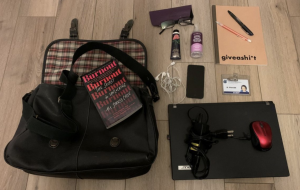
I’ve worked with DeeDee in another MET course, so I knew DeeDee has 3 boys and a busy lifestyle, which is why I was curious to read more about DeeDee’s bag story. When I landed on DeeDee’s post, the first thing I saw was the image of her bag and it was not quite what I expected! I thought her boys were a bit younger, so I expected her bag to be full of bandaids and snacks, but then I read her post and learned that she had graduated from that stage. DeeDee’s bag story started from her high school days, when she traveled to Switzerland and bought her treasured bag.She has been using the same bag for 30 years!! To me, this was astonishing, since these days people change their bag style as the seasons change. For me, this fact/image spoke a thousand words, it told me that DeeDee is patient, caring, and treats her belongings as irreplaceable. As we have learned throughout this course, text and technology has been evolving rapidly over the past few decades, changing the way we view and interact with life around us. However, DeeDee has been able to sustain aspects of a more simplistic life and repurpose them as she moves through life. This got me thinking about how many different versions of ourselves we move through throughout life. Some aspects we leave behind, like typewriters and discman, other aspects we keep continue to shuffle with us, like books and headphones. This demonstrates how nothing in life is static, we are constantly evolving and the world evolves with us.
DeeDee’s Post: https://blogs.ubc.ca/ddperrott/2021/09/17/what-is-in-your-bag/
Nataliia Kudryk: Task 4: Potato Printing
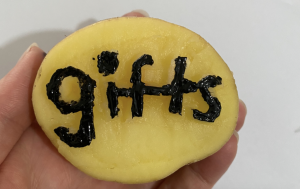
I loved Nataliia’s potato printing task! I personally choose the manual script option because it is a medium I am much more familiar with, so seeing how Nataliia got creative with potato printing was awesome. My first reaction to Nataliia choosing potato printing was that maybe she leans more towards the arts more than writing, but then I learned that this task was also a challenge for her yet she still decided to pursue it. To me, this was especially impressive and respectable because as Nataliia mentioned, the task required a lot of patience and concentration. Nataliia described her “aha” moment, when she realized that her stamp output was not exactly what she was aiming for. Instead of describing this oversight as an error, she was able to see the positive in it, which in this case was that many cultures do read right to left, and that not everything needs to be right or wrong. Nataliia was also able to build an appreciation for letter printing that she might not have otherwise experienced. Her description of her experience with this task makes me want to undertake it myself whenever I have some free time. It made me realize that there was an aspect of text and technology that Nataliia was able to make tangible in her learnings, and I could not have the same experience without trying it myself. Her task made me reflect on why we choose certain mediums over others, which these days, is usually due to convenience. As we discuss in the course, the way text and technology has evolved is largely due to an effort to make life for humans easier. But sometimes we leave certain “inconvenient” tools behind, like potato printing, which in another life may have been more than just printing, but also symbolic, however now it is generally viewed as an arts and crafts exercise. Everything in our world is about perspective and appreciation, and Nataliia’s activity made me realize that I need to start striving for more quality experience over convenience and comfort.
Nataliia’s Post:
https://blogs.ubc.ca/etec540metporgram/2021/10/02/task-4-manual-script-and-potato-printing/
Megan Ravenhill: Task 7: Mode Bending
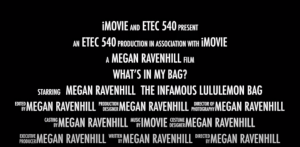
Megan’s mode bending activity consisted of a trailer-like advertisement of her “what’s in my bag” assignment. Her task stood out to me because it was almost the complete opposite of what I did for my assignment. Megan chose to incorporate dramatic music, whereas I chose to avoid audio output. Megan’s video did not focus on her, but rather the objects in her bag, whereas my video displayed me using my objects. Both modes open the door for the audience’s interpretation and assumptions, but in different ways. Megan’s video easily conveyed the emotion she wanted her audience to feel through the audio, which was suspense. This reminds me how important music and audio is in our life because it adds emotion. For example, when you are watching a movie of a family at the park, the music can be uplifting, to symbolize fun and carefree life with children, or the music could be suspenseful, warning the audience that something unexpected might happen. Hence, music can completely change the tone of the content the audience is viewing. Whereas in my case, I chose to opt out of audio all together, relying solely on my expressions and gestures to convey my emotions. I did so at the expense that some people might not interpret my emotions correctly. However, I read Whitney Lafleur’s reflection on my mode bending and she was able to correctly identify my happy emotions:
“She shakes it [my bag] towards the camera with a big smile as if to say, without words, “look at my pretty bag; I love my bag!””
This is up to interpretation for everyone who views it. Some people may understand my gesture in the way I intend them to, while others may have a slightly different interpretation. This highlights why education needs to continue to incorporate different modes of learning, everyone is different! Teaching using only one mode will not be relevant to all students, and imagine going a whole semester feeling like you cannot understand the content the way the teacher wants you to. I believe this class (and program)has made us realize that education is not about succeeding in the modes the teacher wants, but rather allows flexibility for students to safely explore and learn on their own!
Megan’s Post: https://blogs.ubc.ca/mravenhill/2021/10/24/task-7-mode-bending/
Whitney’s Post: https://blogs.ubc.ca/etec540lafleur/2021/11/14/link-6-a-review-of-kirn-bhelas-task-7-mode-bending-assignment/
Whitney Lafleur: Task 8: Golden Record Curation
I really appreciated Whitney’s Golden Record Curation reflection because I could see how aware she was of her own biases. She prefaced her reflection by first acknowledging her privilege, and the parameters she set revolved around global and cultural awareness. I believe that regardless of geographically or culturally background, everyone should be able to acknowledge how their personal biases may influence the decisions they make, including music curation. Although I am not a white woman, I am Punjabi-Canadian and I do have a lot of privilege.
The parameters Whitney identified were geography and personal listenability. Whereas the parameters I chose were world significance, uniqueness in talent, and emotion. Despite different ways to word our criteria, I believe we were both aiming for the same output: a playlist that was reflective of the world, rather than ourselves. However, looking at Whitney’s playlist, I actually like it more than mine, because I still chose to include very Eurocentric pieces, such as Mozart, simply because of the significance it holds in the western world.
In her post, Whitney considers a revised version of this assignment, where she can choose from more sounds. In this version, she would focus on natural sounds. I think this is such a lovely idea! The sounds we find in the natural world are known for reducing stress and calming our mind and body. I think this is a very interesting twist to the assignment and I would be very curious to how others would approach this. Currently, it seems obvious to include sounds from the natural world, but I wonder how I would respond to this revised assignment if Whitney had not already mentioned it.
Whitney’s Post: https://blogs.ubc.ca/etec540lafleur/2021/10/25/task-8-golden-record-curation/
Amy Jazienicki: Task 10: Attention Economy
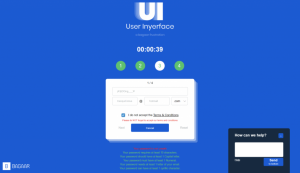
I did not complete assignment 10 because I wanted to focus my energy on completing other assignments that I would not normally encounter in my everyday life, given that as a UX/UI Designer, I encounter and study dark patterns often. That being said, I was extremely excited to hear about my colleagues’ experience with this assignment! In Amy’s post, she mentions how not only are dark patterns extremely difficult to navigate, but also unethical and inaccessible. I completely agree with her, I feel like I could write a book about this reflection, but I’m going to focus on the accessible part here because I believe it is important to address. The rise of technology has altered the landscape of cultures and communication by modifying how we create and respond to the stimuli in our environment. Technology is advancing at lightning speeds, with a hyper focus on how to connect individuals to one another, usually through social media. These technologies tend to focus on their target audience and users, which means minority groups, such as people with accessibility limitations, are often neglected (Kulkarni, 2019). Accessibility refers to the extent to which a product, technology, service, or environment is navigable for persons with disabilities or other functional barriers (Kulkarni, 2019). Today, it is especially important to keep accessibility at the forefront, as the world has shifted away from physical interactions to digital in efforts to eliminate or minimize the spread of COVID-19. Persons with pre-existing accessibility limitations are further disabled if they cannot access information digitally. The frustration everyone experienced while completing this task is the feeling that people with accessibility limitations encounter daily. As Amy suggests, we need processes and patterns in place to enforce transparency and good UX.
Amy’s Post: https://blogs.ubc.ca/etec540ajazieni/2021/11/10/task-10-attention-economy/
Angela Beckett: Task 12: Speculative Futures
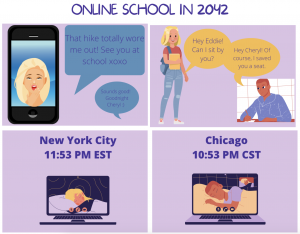
I really enjoyed reading Angela’s speculative futures post because of how descriptive and immersive the experience was. I was able to completely imagine this new reality that she created, especially because the first narrative connected to COVID-19, which is still such a strong force in our lives today. Additionally, Angela taps into something that is very personal and relevant to everyone’s life, time. At some point in our life, we all reflect on our time, during the bad times we want it to speed up, and during the good times slow down. A prime example that comes to my mind is grade school and summers. When we were all children in grade school, the year would trickle by extremely slowly, and often summers would be even slower because we spent all day at home, with parents at work. By the time August rolled around, everyone would be ready for back to school shopping and picking first day outfits. But as we grow older, our lives get busier and busier, and time seems to move quicker and quicker. By the time we’re only 30, we start begging for more time. Everyone’s experience might not be exactly like this, but we all go through some form of time distortion. Angela’s speculative future solves one of these problems by creating more time for fun and leisure in our lives. Not only do we get more freedom, but this also removes the extreme pressures and stress of being in school. The nature of institutional school itself is robotic and unhealthy, training young people to spend their days indoors stressing over assignments, rather than enjoying the natural world. As you may be able tell, I believe this type of freedom is priceless and I believe it would bring so much value to human life and earth. Oh how I wish this wasn’t speculation!
Angela’s Post: https://blogs.ubc.ca/etec540abeckett/2021/11/14/task-12-speculative-futures/
References
Kulkarni, M. (2019). Digital accessibility: Challenges and opportunities. IIMB Management Review, 31(1), 91-98.